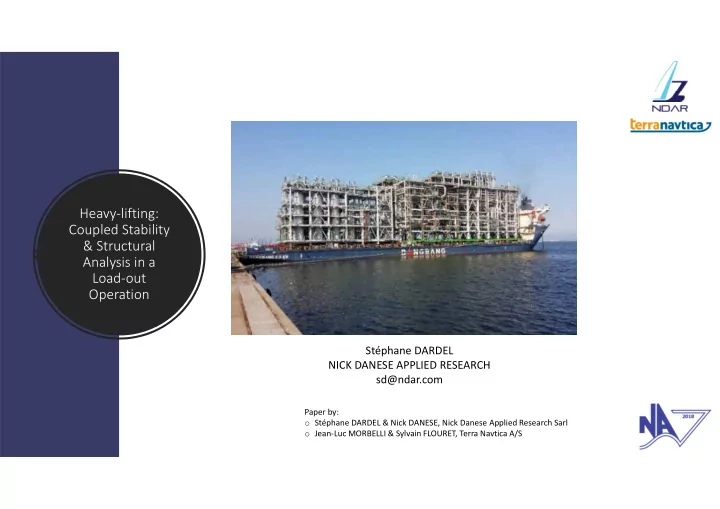

Heavy-lifting: Coupled Stability & Structural Analysis in a Load-out Operation Stéphane DARDEL NICK DANESE APPLIED RESEARCH sd@ndar.com Paper by: o Stéphane DARDEL & Nick DANESE, Nick Danese Applied Research Sarl o Jean-Luc MORBELLI & Sylvain FLOURET, Terra Navtica A/S
2 DIGITAL MODELS: STRUCTURAL MODEL (MAESTRO Marine) HYDROSTATIC MODEL (GHS) Working in synchrony ! Heavy-lifting: coupled stability & structural analysis in a load-out operation
HYDROSTATIC MODEL: STRUCTURAL MODEL: - Drafts & trim & hydrostatics - Finite Element model - Stability - Automatic transfer of tank loads from GHS to - Tank status MAESTRO - Ballast sequence - Hydrostatic balance - Ballast pump capacity check - --> Synchrony with GHS - Longitudinal strength & girder deflection (beam theory) - Global strength & deflection, along 3 axis - Torque - Torque - Local structural strength: Limit State Analysis Heavy-lifting: coupled stability & structural analysis in a load-out operation
Cargo control in GHS: Heavy-lifting: coupled stability & structural analysis in a load-out operation
MAESTRO Marine’s Limit State analysis: Beyond customary stress maps. Load bearing capability of a structural assembly as a whole. 14 failure modes. « Evaluation patches » are rated with an adequacy parameter, always lying within the normalized limits of -1 to +1 Heavy-lifting: coupled stability & structural analysis in a load-out operation
Engineering: Hydrostatic model: - Prepared in a few hours, - Early feasibility checks: payload capcity vs drafts, longitudinal strength limits, ballast capacity, etc. Structural model: - 3 man-weeks. acceptable even in an initial study - Invaluable gains in predicting structural behaviour: identifying weak zones, planning eventual reinforcing very early in the process, etc. Model creation = one-time job, directly re-usable for future operations Heavy-lifting: coupled stability & structural analysis in a load-out operation
Next? Integrated « Hydro + structural » model supports at-sea operations too, opening new areas of engineering analysis and behavioural prediction: - Combination and interaction of cargo’s and carrier’s strength and overall girder stiffness, - Assessment of risks to the cargo’s integrity taking into account waves, sea-states, ship speed and duratio,n of the voyage, - Integrated Seakeeping analysis: Extreme load analysis, Fatigue analysis, Voyage prediction, planning and critical decision making during the passage. Heavy-lifting: coupled stability & structural analysis in a load-out operation
Thank you! Heavy-lifting: coupled stability & structural analysis in a load-out operation
Recommend
More recommend